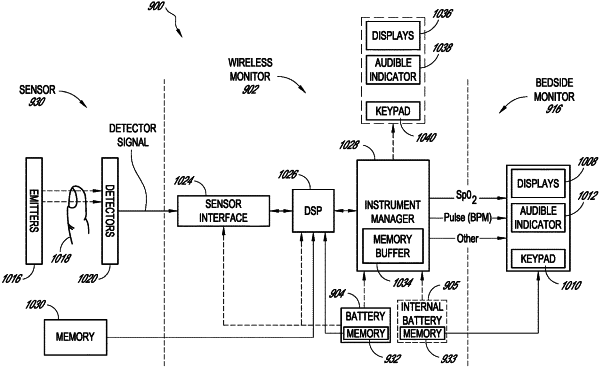| CPC A61B 5/14552 (2013.01) [A61B 5/002 (2013.01); A61B 5/0022 (2013.01); A61B 5/0024 (2013.01); A61B 5/0059 (2013.01); A61B 5/02416 (2013.01); A61B 5/0261 (2013.01); A61B 5/0295 (2013.01); A61B 5/14551 (2013.01); A61B 5/6826 (2013.01); A61B 5/6831 (2013.01); A61B 5/6833 (2013.01); A61B 5/725 (2013.01); A61B 5/7405 (2013.01); A61B 5/7425 (2013.01); A61B 5/7445 (2013.01); A61B 5/746 (2013.01); A61B 2560/0214 (2013.01); A61B 2560/0266 (2013.01); A61B 2560/0475 (2013.01)] | 16 Claims |

|
1. A wireless monitoring system comprising:
a physiological sensor configured to detect physiological information from a user; and
a wireless monitor comprising a display and configured to receive the physiological information from the physiological sensor and configured to at least partially process the physiological information,
wherein the wireless monitor is configured to automatically transmit the at least partially processed physiological information to a bedside monitor over a first, short-range wireless technology when a signal strength of the first wireless technology allows the at least partially processed physiological information to be transmitted over the first wireless technology and automatically transmit the at least partially processed physiological information to device location other than the bedside monitor over a second wireless technology when the signal strength of the first wireless technology does not allow the at least partially processed physiological information to be transmitted over the first wireless technology, and
wherein the wireless monitor is configured to activate the display when the wireless monitor transmits the at least partially processed physiological information over the second wireless technology and deactivate the display when the wireless monitor transmits the at least partially processed physiological information over the first wireless technology.
|